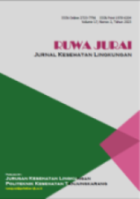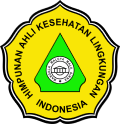Association between Access to Clean Water and Health Services and the Incidence of Stunting in Sungai Landas Village, Banjar District, South Kalimantan
DOI:
https://doi.org/10.26630/rj.v19i1.4991Keywords:
Stunting, Access to Clean Water, Access to Health ServicesAbstract
Stunting among infants and toddlers in Sungai Landas Village, Banjar Regency, remains above the national target. Access to clean water and healthcare services plays a crucial role in preventing stunting, but the relationship between these two factors in this area has not yet been studied simultaneously. The study aim to analyze the association between access to clean water and access to healthcare services with the incidence of stunting among children under five in Sungai Landas Village. A quantitative cross-sectional study was conducted involving 30 children under five selected through purposive sampling. Data were obtained using an adapted Indonesian Nutritional Status Survey (SSGI) questionnaire, which assessed water source quality and the frequency of access to healthcare services. Stunting status was determined by measuring height-for-age according to Regulation of the Minister of Health No. 2 of 2020. Bivariate analysis was run with Fisher’s Exact test to assess the association between access to clean water and healthcare services and stunting incidence. Bivariate analysis revealed no significant association between access to clean water and stunting (p = 0.267), nor between access to healthcare services and stunting (p = 0.469). There is no significant association between the type of drinking water source or the frequency of healthcare service access and stunting among children under five in Sungai Landas Village. Other factors, such as a balanced diet and hygienic practices, also play a role. Recommendations include strengthening education on water treatment and family nutrition, improving the quality of healthcare services, and implementing multisectoral programs for more effective stunting reduction.
References
Ardhiyanto, R. V., & Sari, D. P. (2024). Hubungan Keberadaan Coliform Dalam Air Minum Dan Pola Asuh Ibu Dengan Kejadian Stunting Di Kecamatan Nguter Kabupaten Sukoharjo. JKM (Jurnal Kesehatan Masyarakat) Cendekia Utama, 12(2), 212. doi: https://doi.org/10.31596/jkm.v12i2.2409.
Arifuddin, A., Prihatni, Y., Setiawan, A., Wahyuni, R. D., Nur, A. F., Dyastuti, N. E., & Arifuddin, H. (2023). Epidemiological model of stunting determinants in Indonesia. Healthy Tadulako Journal (Jurnal Kesehatan Tadulako), 9(2), 224–234. doi: https://doi.org/10.22487/htj.v9i2.928.
Aurelia, Y. (2024). 1000 HPK Kunci Cegah Stunting. ayosehat.kemkes. https://ayosehat.kemkes.go.id/1000-hpk-kunci-cegah-stunting
Griayasa, G. A. K., Juwita, D. A. P. R., & Kartinawati, K. T. (2024). Faktor-faktor yang mempengaruhi kejadian stunting pada anak balita di wilayah kerja Puskesmas Nulle Timor Tengah Selatan Nusa Tenggara Timur. Aesculapius Medical Journal, 4(1), 81–93. doi: https://doi.org/10.22225/amj.4.1.2024.81-93.
Hasanah, S., Noor, M. S., Rosida, L., Triawanti, T., & Al-Audhah, N. (2025). Hubungan berat badan lahir, asi ekslusif dan riwayat penyakit infeksi dengan kejadian stunting di Puskesmas Berangas. Homeostasis, 7(3), 639–648. doi: https://doi.org/10.20527/ht.v7i3.14600
Imeldawati, R. (2025). Dampak terjadinya stunting terhadap perkembangan kognitif anak: literature review. Jurnal Medika Nusantara, 3(1), 101–107. doi: https://doi.org/10.59680/medika.v3i1.1632.
Jannah, M., Ramadhaniah, R., & Aramico, B. (2024). Hubungan asi ibu, penyakit infeksi dan akses pelayanan kesehatan dengan kejadian stunting pada balita. Jurnal Promotif Preventif, 7(5), 1063–1069. doi: https://doi.org/10.47650/jpp.v7i5.1533.
Kamilah, A., & Ramadhaniah, T. D. S. (2022). Hubungan akses pelayanan kesehatan, bblr, asi eksklusif dan asupan protein dengan kejadian stunting pada balita usia> 6-59 bulan di wilayah kerja Puskesmas Baitussalam Kecamatan Baitussalam Kabupaten Aceh Besar tahun 2022. Journal of Health and Medical Science, 1(1), 171–177. URL: https://pusdikra-publishing.com/index.php/jkes/article/view/965.
Kementerian Kesehatan Republik Indonesia. (2019). Laporan Nasional Riset Kesehatan Dasar 2018.
Kementerian Kesehatan Republik Indonesia. (2024a). Panduan Kegiatan Hari Gizi Nasional ke-64 Tahun 2024.
Kementerian Kesehatan Republik Indonesia. (2024b). Survei Kesehatan Indonesia (SKI) 2023 dalam Angka. Badan Kebijakan Pembangunan Kesehatan.
Lestari, P. P., Rahmah, A., & Mutmainah, S. G. (2025). Analisis determinan masalah stunting di Kabupaten Banjar. INVOLUSI: Jurnal Ilmu Kebidanan, 15(1), 12–18. doi: https://doi.org/10.61902/involusi.v15i1.1456.
Munthe, S. N., Silalahi, R. M., Pertiwi, K. C., Permanasari, V. Y., & Andriani, H. (2024). Kajian literatur: pengaruh konsumsi air bersih terhadap stunting pada anak yang berasal dari keluarga berpendapatan rendah. MAHESA: Malahayati Health Student Journal, 4(2), 566–580. doi: https://doi.org/10.33024/mahesa.v4i2.13301.
Nisa, S. K., Lustiyati, E. D., & Fitriani, A. (2021). Sanitasi penyediaan air bersih dengan kejadian stunting pada balita. Jurnal Penelitian Dan Pengembangan Kesehatan Masyarakat Indonesia, 2(1), 17–25. doi: https://doi.org/10.15294/jppkmi.v2i1.47243.
Orisinal, O., Yasni, H., Rasima, R., Usrina, N., & Raisah, P. (2025). Faktor-faktor yang berpengaruh terhadap kejadian stunting pada balita usia 24-59 bulan yang tinggal di pesisir pantai. MAHESA: Malahayati Health Student Journal, 5(4), 1723–1740. doi: https://doi.org/10.33024/mahesa.v5i4.17224.
Paramasatya, A., & Wulandari, R. A. (2023). Korelasi akses sanitasi dan akses air minum dengan kejadian stunting pada balita di wilayah Kabupaten Serang tahun 2022. Jambura Journal Of Health Science And Research, 5(2), 695–706. doi: http://dx.doi.org/10.35971/jjhsr.v5i2.19145.
Pemerintah Kabupaten Banjar. (2021). Peraturan Bupati Banjar Nomor 32 Tahun 2021 tentang Strategi Percepatan Penurunan angka Prevalensi STUNTING melalui Kelompok Relawan Menuju Anak Indonesia Sehat Bebas Stunting (Kawan Manis Best) di Kabupaten Banjar.
Pratiwi, R. D., Martini, N. K., & Nyandra, M. (2021). Peran Ibu dalam Pemberian Makanan Bergizi Pada Balita Status Gizi Baik yang Kesulitan Makan. Jurnal Kesehatan, 14(2), 119–125. doi: https://doi.org/10.23917/jk.v14i2.11759.
Rahayuwati, L., Ibrahim, K., Hendrawati, S., Sari, C. W. M., Yani, D. I., Pertiwi, A. S. P., & Fauziyyah, R. N. P. (2022). Pencegahan stunting melalui air bersih, sanitasi, dan nutrisi. Warta Lpm, 25(3), 356–365. doi: https://doi.org/10.23917/warta.v25i3.1031.
Razaq, A. A., & Y.E. Soekatri, M. (2022). Relationship of worm infection and hemoglobin levels to stunting in toddlers aged 3-5 years in Indramayu. SANITAS: Jurnal Teknologi dan Seni Kesehatan, 13(2), 100–109. doi: https://doi.org/10.36525/sanitas.2022.10.
Sardina, S., Riadi, S., & Natsir, N. (2022). Implementasi program penanggulangan stunting pada anak bawah lima tahun (balita) di Kabupaten Donggala. Katalogis, 10(2), 121–128. doi: https://doi.org/10.22487/katalogis23022019.2022.v10.i2.pp121-128.
United Nations. (n.d). End hunger, achieve food security and improved nutrition and promote sustainable agriculture. Retrieved June 2, 2025, from https://sdgs.un.org/goals/goal2.
Wiyono, S. (2022). Modelling of toddlers stunting prevention in the first thousand days of urban area life. SANITAS: Jurnal Teknologi Dan Seni Kesehatan, 13(2). doi: https://doi.org/10.36525/sanitas.2022.17.
World Health Organization. (2017). Guidelines for drinking-water quality, 4th edition, incorporating the 1st addendum. https://www.who.int/publications/i/item/9789241549950.
World Health Organization. (2024). Stunting in focus: challenges, successes, and a path forward to 2030. https://www.who.int/news-room/events/detail/2024/11/21/default-calendar/stunting-in-focus-challenges-successes-and-a-path-forward-to-2030.
Yuwanti, Y., Himawati, L., & Susanti, M. M. (2022). Pencegahan stunting pada 1000 HPK. Jurnal ABDIMAS-HIP Pengabdian Kepada Masyarakat, 3(1), 35–39. doi: https://doi.org/10.37402/abdimaship.vol3.iss1.166.
Downloads
Published
How to Cite
Issue
Section
License
Copyright (c) 2025 Ruwa Jurai: Jurnal Kesehatan Lingkungan

This work is licensed under a Creative Commons Attribution-NonCommercial 4.0 International License.

Ruwa Jurai: Jurnal Kesehatan Lingkungan is licensed under a Creative Commons Attribution-NonCommercial 4.0 International License.
Authors who publish with this journal agree to the following terms:
- Authors retain copyright and grant the journal right of first publication with the work simultaneously licensed under a Creative Commons Attribution-Non Commercial License that allows others to share the work with an acknowledgment of the work's authorship and initial publication in this journal.
- Authors are able to enter into separate, additional contractual arrangements for the non-exclusive distribution of the journal's published version of the work (e.g., post it to an institutional repository or publish it in a book), with an acknowledgment of its initial publication in this journal.
- Authors are permitted and encouraged to post their work online (e.g., in institutional repositories or on their website) prior to and during the submission process, as it can lead to productive exchanges, as well as earlier and greater citation of published work.









